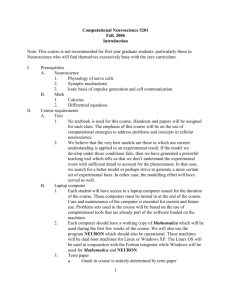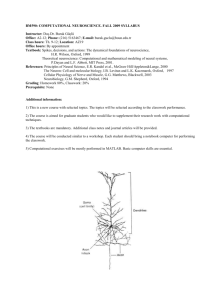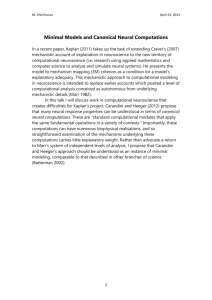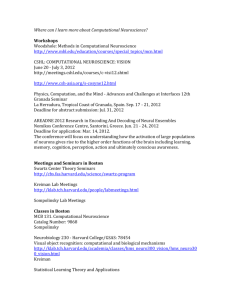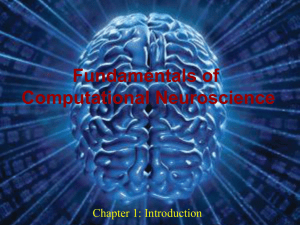Lecture notes
advertisement
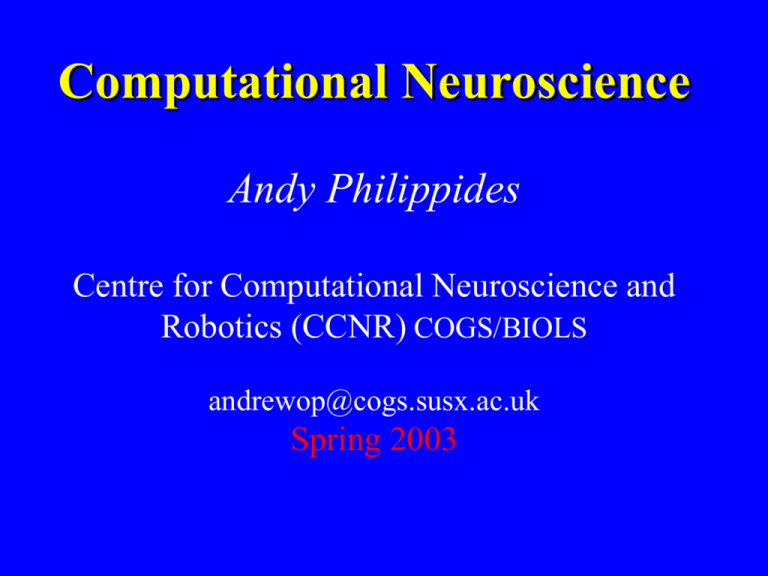
Computational Neuroscience Andy Philippides Centre for Computational Neuroscience and Robotics (CCNR) COGS/BIOLS andrewop@cogs.susx.ac.uk Spring 2003 Teaching 2 hours per week: Monday 9.15-11.05 Nominally 1 hour lecture, 1 hour seminar, but may vary Office hour: Friday12.30-1.30, BIOLS room 3D10 Lecture notes available online soon Assessment:Seminar presentation 25% • 30 mins presentation (25 mins + 5 mins questions) • Papers chosen from the reading list. Papers of your own choosing may be acceptable but MUST be ratified by me • Presentations start in week 4 (order decided by subject) • Present the ideas of the paper clearly • Give your opinion on the strengths and weaknesses of the ideas/research • Be prepared to answer questions on the paper • A little reading around the subject will usually be required for a good presentation • A printout of any resources used must be given to me for marking and external assessment Assessment: Project 75% • Programming project to implement a computational neuroscience model • Due in Wed 23rd April 12 noon • Approx 3500 words • Some suggested projects but you can choose your own subject to ratification by me • More details in week 5 Course summary Computational Neuroscience aims to understand the mechanisms underlying brain function by building quantitative models. The course is intended to introduce the basic concepts of this area and give details of some of the standard models and approaches Biological background will be given together with the model though some basic knowledge is assumed Some mathematics will be required as the majority (all?) of the models are mathematical, but I will attempt to keep it to a minimum Don’t Panic about the Maths! • You only need to know enough to understand what is going on not how to do it • Maths is necessarily abstract and may not be clear at first, but this is to be expected • It may take time (several viewings) to understand things so be patient Caveat Computational neuroscience is a huge topic and this is a short course The lectures will not cover everything Will try to cover the basics of a subject and give pointers to more advanced topics/areas of interest Course Structure 1 1. Course introduction: What is computational neuroscience, why is it needed, levels of modelling, neural signalling 2/3. Single neuron models (start small and work up): Basics of neural signalling, membrane equation, cable theory, action potentials, Hodgkin-Huxley model, beyond HH model 4. Networks of neurons: what neuron models are used, how they are connected, oscillations in networks of neurons, map formation Course Structure 2 5. Learning: modelling synaptic learning, how learning shapes neural networks 6. Spiking networks: Models of spiking neurons and issues of spike timing and coincidence detection 7. Gaseous neurotransmission: mathematical models of diffusion, more abstract models of diffusion 8. Systems level neuroscience. Examples of higher level models (if we have enough time…) Further reading Purves, et al eds. Neuroscience. Sinauer, 97 (many neuroscience texts at various levels: pick one that’s right for you) Abbott LF & Dayan P: Theoretical Neuroscience. MIT Press, 2001 Computational Neuroscience. Realistic Modeling for Experimentalists By Erik De Schutter. CRC Press, 2000 Koch C & Segev I. Methods in neuronal modeling: from ions to networks. MIT Press, 1998 Spikes, Rieke et al, 1996 Many others: see http://home.earthlink.net/~perlewitz/books.html What is computational neuroscience? • Mathematical modelling: the construction of quantitative models to understand observable phenomena. Explaining phenomena in terms of underlying mechanisms. • Computational modelling: Modelling what the brain does in terms of computations. Crudely, trying to understand the brain as a computing device: a rather newer idea (eg Info theory etc) • Relation to AI/ALife: These try to understand computing devices in general and how best to solve computational problems. CN studies a particular computing device and how it solves problems. Sometimes uses same tools (eg neural nets) but one must be careful. Also biology provides great deal of inspiration for Alife techniques Why do we need models? • When we have enough data about the brain, won't we understand how it works? Analogy with astronomy. • Common misuderstanding: Modelling is a form of hypothesis testing. • Force one to make assumptions explicit. Can only get so far with hypotheses expressed in intuitive terms. E.g. ``visual experience affects visual development''. • Enables many ``virtual'' experiments to be done, can pinpoint the one that is most crucial. • Can lead to unexpected predictions. • Often much quicker/easier to try out ideas eg lesioning studies in silica rather than in vitro/vivo so can guide potential experiments What makes a good model? • However, its easy to make a bad Alifey model • Good to have close contact with neuroscientists • (Maybe) “Model should not only replicate existing data but must also make predictions about the biological system” [Editor of biological journal] (??! Discuss) • Roger Quinn: cockroach models normally only informative when they don’t work Levels of modelling • Many different types of models: continuum from very realistic to very abstract. All models must make simplifications to be useful. • E.g. model of single neuron. – – – – – – – – – Binary threshold unit Continuous unit Integrate-and-fire (continuous in time) Spiking A few compartments Many compartments Individual channels Detailed model of channel dynamics etc Which to use? • Depends on purpose of the model! Different types appropriate for different sorts of questions. Should become clearer as we learn about particular types of models in the course. • Eg: Top-down vs bottom up models. – Top-down: Start with idea about abstract task / problem, figure out good way to solve it, see if that's what the nervous system does. – Bottom-up: Look closely at nervous system, try and figure out what its doing, derive the task / problem from there. Models can be categorised in other ways: • Biological perspective (Molecular, neuronal etc) • Marr (82): – Computational (what computation is to be performed, in terms of optimality, modularity etc), – algorithmic (looks at nature of computations performed) – implementational (how algorithm is implemented) • Abbot and Dayan (2001) – Mechanistic: based on known anatomy and physiology – Descriptive: summarizes large amounts of experimental data – Interpretive: explores behavioural and cognitive significance of nervous system function
